
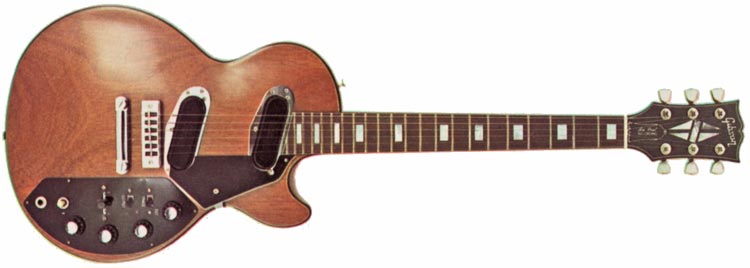
The Gibson Les Paul Recording guitar evolved from a couple other models, first produced in the late sixties. These were pivotal times for the world guitar markets. Mass production was becoming the norm, and American guitar companies were struggling to compete with their cheaper Japanese rivals. Gibson did not stop experimenting, however, and guitars such as the Les Paul Personal, and Les Paul Professional (with a matching Les Paul Bass) appeared, sporting novel electronics combined with the quality of materials and craftsmanship that Gibson was famous for. These were low impedance instruments designed specifically for recording; 'a guitar that can virtually produce any sound that you would want'. Les Paul describes the thinking behind this series
“For years i've worked to produce a multitude of distinctive guitar sounds. The hang-up was to obtain everything in one guitar, now i'm not talking about gimmickry, i'm talking about the real McCoy; authentic guitar sounds, the type of highs that can rip your ears off, the type of bass response that's clean and clear. Every note must be balanced and offer maximum sustain.”
Gibson changed hands in December 1969, and number of models changed significantly over the next few years; the Les Paul Bass and Professional guitar were redesigned to become the Les Paul Recording guitar and Les Paul Triumph bass respectively. Gone was the dark Walnut finish, in favour of a much lighter Natural Mahogany, and the weight was also reduced somewhat. Functionally the instruments were unchanged though - with one important caveat - the original low impedance instruments required a transformer cable to produce a suitable signal for normal (high impedance) amplifiers. These new guitars had the transformer built into the guitar - activated via the hi/lo impedance switch. The controls are a little complicated and a new owners manual was also printed in 1971.
“To produce a truly fine instrument like the new Les Paul Recording guitar, you need more than just fine materials. You need expert innovators, skilled craftsmen and knowledgeable engineers inside and out.
You also need a man who is an expert in the guitar field to advise and recommend features and specifications that will cause the finished product to be unique and distinctive.
Gibson long recognized as the world's leading guitar manufacturer, met these requirements when they combined their talents with the knowledgeable recommendations of a man who has come to be known to millions of music lovers as "Mr. Guitar" ...Les Paul”
The Les Paul Recording was launched in 1971, first appearing in Gibson price lists in June of that year. The launch price of $625 was higher than that of the Les Paul Custom ($595), but in between the previous prices for the Personal and Professional that it replaced ($690 and $525 respectively, Sept 1970). According to published shipping statistics, 236 guitars left the Gibson Kalamazoo plant.
The 1971 brochure produced to accompany the launch was entitled Low Impedance for High Performance included an interesting flexi-disc demonstration of some of the many sounds possible. The disc was narrated by Les Paul himself, and guitars were played by Bruce Bolen. Side one featured the Les Paul Recording guitar, whilst side 2 featured a track named Tomorrow, today recorded by Bruce Bolen using both instruments. Have a listen
Tomorrow, today
The rest of the clips can be heard here.
Sales in 1972 were moderate - 1314 guitars shipped. Far better than 1971, but by comparison the Les Paul Custom, Deluxe and Standard shipped 4062, 5194 and 1046 units respectively.
There was big drive for the new models in early 1972, with a Gibson dealer letter declaring March & April are Les Paul months!. Gibson distributed the brochures with flexi-disc to all it's dealers, as well as including it in a special centerfold in Guitar Player magazine - the letter to dealers read...
“How would you like to hear these instruments? We have made it possible for you to hear the Les Paul Recording guitar and Les Paul Triumph bass by simply turning on your record player. Attached you will find a beautiful brochure illustrating each instrument in vivid color. In the brochure you will find a record narrated by the creator himself, Mr. Les Paul!”
“To aid you in selling these "versatile" new instruments, the widely circulated Guitar Player magazine will feature each of these instruments in the April issue, which is now being mailed to 70,000 readers. During the months of March and April, literally thousands of readers will be reading about these fantastic instruments, and better yet, listening to the Les Paul record which will be attached to the centerfold ad.”
In 1972 Gibson also included the Recording as part of it's Guitar of the Month series - The Gibson Les Paul Recording Showcase - mostly alongside fine electric acoustic models. See the rest of the showcase series flyers here.
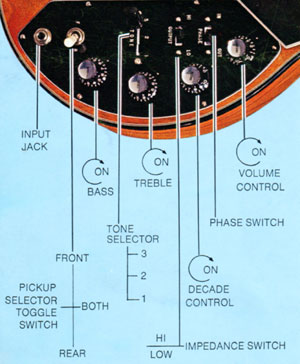
Bass, Treble and Volume Self explanatory. The bass and treble have a very wide range, but most importantly work independently from each other, dialing in more treble does not affect the level of bass, and vice versa
Decade Control This eleven position switch tunes or alters the treble harmonics. Produce "biting" or "silky" highs with simplicity.
Phase Control Only works when both pickups are selected.
Impedance Selector Hi for live use or Low for studio use (or live use with a Low-Impedance amplifier).
Tone Selector Three settings: 1, 2, and 3. This switch does not actually change the tone produced by the instrument per se.. it acts as a bypass, inactivating certain controls - hence allowing quick and reversible changes between settings that would otherwise be impossible particular in a live setting. In position 2 (middle), nothing is bypassed. All controls function as described above. In position 1 the pickup selector switch and treble and bass controls are inactive - both pickups are selected by default. In position 3 only the treble and bass controls are bypassed. These controls are explained in detail on pages 2 and 3 of the Les Paul Recording owners manual.
Around 1976, the control layout of the Les Paul Recording changed. It was somewhat tidier with the four control pots in a row, and with the hi/lo impedance switch removed in favour of two separate output jacks, one for high, one for low impedance - and both situated on the guitar edge rather than mounted into the front of the guitar on the control plate. What's more, the pickup selector switch was moved from the control plate to the top edge of the guitar's body - the typical location of this switch in other Les Paul models. The 1978 control description flyer (reproduced here) details the later period Recording guitar controls. Note that although functionally identical, the tone switch positions are numbered in reverse order to the previous version.
Left: Keith Richards on the cover of the 1975 Gibson Les Paul brochure. Right: the 1978 Gibson Quality / Prestige / Innovation catalogue
The Les Paul Recording was shipped from 1971, with the strongest sales in 1973. Unfortunately they dropped of throughout the 1970s; the model was last included in the 1978 Gibson catalogue, but only remained in price lists until January 1979. The Les Paul Recording was still shipped, however, at least until 1980, in very small numbers - possibly even later.
A total of 5380 Recording guitars were shipped between 1971 and 1979.
| 1971 | 1972 | 1973 | 1974 | 1975 | 1976 | 1977 | 1978 | 1979 |
| 236 | 1314 | 1759 | 915 | 204 | 332 | 362 | 180 | 78 |
Electric guitar advertisements originally published from 1972 onwards. Click on the images for larger copies. Check out other vintage Gibson advertisements
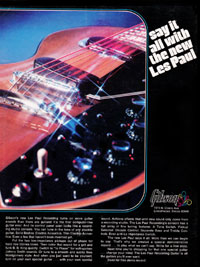
Gibson Les Paul Recording - Say it All With the New Les Paul (1972)
Early seventies advertisement for the Gibson Les Paul Recording guitar
Gibson's new Les Paul Recording turns on more guitar sounds than there are guitars! It's the first computer-like guitar...
[more]
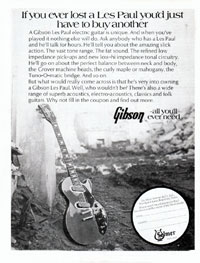
Gibson Les Paul Recording - If You Ever Lost a Les Paul, You'd Just Have to Buy Another (1972)
Early seventies British advert for the Les Paul Recording guitar, by Selmer, UK Gibson distributors at the time.
A Gibson Les Paul electric guitar is unique. And when you've played it nothin...
[more]
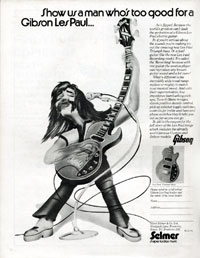
Gibson Les Paul Recording - Show us a man whos too good for a Gibson Les Paul (1974)
UK ad for the Triumph bass and Les Paul Recording guitar. The add was produced by Selmer who were the British distributors of Gibson Instruments.
...he's flipped. Because the world's greates...
[more]
$3649
$4000
$3600
$4495
C $3800
€638